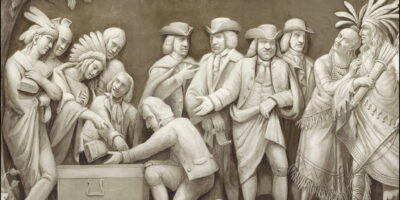Even Swedish Socialism was Violent
Few subjects are more taboo among self-described socialists than the historical track record of socialism in action.
Bernie Sanders recently bristled at the suggestion of any commonality between the government of Venezuela and his own platform, even though less than a decade ago he was touting the country along with other leftist governments in South America as exemplars of the “American dream.”
When Anderson Cooper presented Alexandria Ocasio-Cortez with a similar question, she scoffed at the suggestion. It is unfair to link their ideology to its violent forebears, they insist, because the “democratic socialism” they envision is a Scandinavian-style welfare state, modeled after the economy of Sweden.
There are many problems with this comparison. Sweden’s government has actually been trending away from the centrally planned economic approach favored by Sanders and Ocasio-Cortez. The country reined in public spending with a system of budget caps in the 1990s, scrapped its wealth tax in 2007, and has generally followed a path of privatization and deregulation over the past two decades.
But there’s also a neglected dark side to the Swedish welfare model that its “democratic socialist” admirers seldom mention. That same welfare system developed in explicit conjunction with a violent and coercive eugenics policy, intended to ensure its fiscal solvency and prevent abuses of its programs by persons who were deemed genetically “unfit” by the state.
Both policies trace their modern origins to the 1930s with the political ascendance of the Swedish Social Democratic Party (SDP). Following an SDP victory in 1932, Swedish premier Per Albin Hansson organized his government around a principle he dubbed “folkhemmet,” roughly translated as “the people’s home.” This new philosophy sought to bring private industry into economic and political partnership with the state, subject to socially progressive regulatory guidance as an alternative to a more rigid centrally planned approach, as seen under Soviet socialism.
Along with egalitarian measures intended to tax and redistribute wealth, Hansson also envisioned a greater role of government involvement in daily economic life to achieve a sweeping set of social goals. His prescription entailed taking a hands-on approach to the social safety net, wherein poverty alleviation, public education, health care, public housing, old age pensions, and child care formed a comprehensive package of state-provided “social well-being.”
The folkhemmet platform would dominate Swedish politics until the 1970s, overseeing the design and implementation of the welfare state that Sanders, Ocasio-Cortez, and other “democratic socialists” celebrate today.
Although politically popular, the SDP’s programs created new economic strains on the government. They imposed unprecedented expenses on the public treasury. In addition, Sweden was experiencing a declining birth rate, which portended fiscal insolvency as an aging population left the workforce and became public pensioners. If 1930s birth rate trends continued, the population of the elderly would surpass the income-generating workforce by mid-century, eventually resulting in the fiscal collapse of the entire system.
These issues became the subject of the influential 1934 book Crisis in the Population Question by the husband-and-wife team of Gunnar and Alva Myrdal. To this day the Myrdals remain intellectual giants in Scandinavian social democratic politics, and their economic beliefs are occasionally invoked as a model for Bernie Sanders to follow in the far-left press. An economist and member of the Swedish parliament, Gunnar went on to win the Nobel Prize in economics in 1974. Alva, trained as a sociologist, held a number of prominent diplomatic appointments and was awarded the Nobel Peace Prize in 1982. Their book became an intellectual blueprint for policy under the SDP’s Ministry of Social Affairs, especially as it concerned the need to stimulate population growth.
The Myrdals prescribed a state-ordered natalist policy to boost the birth rate. Child rearing assistance, public health care provision, paid medical leave after childbirth, housing assistance and rent subsidies for parents, and robust expenditures on public education could all be deployed to incentivize fertility, as well as socially engineer a working population that would be able to sustain its pensioners. The SDP politicians saw a double-edged sword in this approach however, as it also incentivized the poorer classes to reproduce — and at a faster rate than the wealthy. On the surface this chafed with the SDP’s emphasis on social equality. If new births disproportionately came from the lower classes, the Myrdals feared, they could become additional drains on the public treasury by becoming lifelong dependents on the very same welfare state.
To counteract the perceived risk of welfare dependence, the SDP government consciously paired its new welfare policies with a complementary system of eugenic laws — intended to prevent or dissuade “unfit” persons from reproducing. These included a narrow compulsory sterilization program, applied to persons with hereditary “defects,” and a much larger “voluntary” sterilization program targeting behavioral considerations. As part of the latter program, the government could induced lower-class citizens to submit to the procedure by using the suasion and levers of the new welfare state itself.
The “voluntary” measures went far beyond involuntary sterilization, which was restricted by law to explicit eugenic reasons. As a 1997 study of the program documented, government officials are known to have used submission to “voluntary” sterilization as a condition for release from mental institutions and public hospitals, for continued access to certain forms of public housing, and even marriage licensing among the poor. In total, an estimated 63,000 Swedes were sterilized between the 1930s and the expiration of the main eugenic law in 1976.
Coercive policies also extended beyond eugenic sterilization, forced and voluntary. As part of the same effort to limit the fiscal strain of welfare dependents, Sweden adopted a parallel system of “environmental” policies where children were forcibly removed from parents and households that the government deemed unsuited for a child’s social development. Swedish authorities used poverty, alcoholism, perception of mental disorders, and a multitude of other discretionary diagnoses to forcibly remove an estimated 250,000 children into state-supervised foster care during this period. According to the theory, this socially engineered change in environment would reduce the child’s likelihood of becoming a dependent.
Elements of both approaches — eugenic and environmental — may be found throughout the Myrdals’ writings, even though some of their modern enthusiasts have tried to rehabilitate the couple by downplaying their commitments to explicitly racial variants of the policy. After the adoption of Sweden’s eugenic laws in the 1930s, both continued to espouse the state-sanctioned social engineering as a necessary and complementary component of the Swedish welfare model. They remained central figures in Swedish politics for the next half-century.
While their Swedish population studies usually took the form of dry academic works, Alva Myrdal laid out the policy implications more explicitly in a little-studied but remarkably candid article from 1939. As its opening line revealed, she sought to delineate a “democratic population policy” as Sweden’s “enlightened” alternative to the “contemporary fascist and communist population experiments.” After outlining the case for using the welfare state to stimulate the birth rate, Alva summarized the paradoxical situation that Sweden faced: “quantity should not be bought by sacrificing quality.”
She explained that Sweden’s racial homogeneity and mobile social structure gave its model advantages over other countries, and stressed a “practical value premise that the main social groups be considered of equal hereditary worth.” There remained however “a small bottom layer of society [that] could rightly be regarded as biologically inferior” and that “should not be classified within any of the large socio-economic classes.” This premise limited the scope of “negative eugenics,” but among the affected, involuntary “sterilisation, however, is utilized against a residuum of all social classes whose perpetuation is considered least desirable.”
Pointing out the narrow scope of the measure, Alva then touted a proposed voluntary sterilization law that the SDP government would soon enact in 1941:
Sterilization is considered to be indicated when the defect of which there is risk of perpetuation by heredity is a grave one (mental or bodily illness, deformity, psychopathy or genuine epilepsy). Carriers who do not show the trait may be sterilized under this law but not under the previous one. Further recognized reasons for sterilization are found in cases in which persons would be incapable of caring for, or rearing children, social and economic insufficiencies being also taken into consideration as adding weight to other reasons for sterilization. Having thus given the legal provision for excluding from procreation the decidedly undesirable group, a border-line group has next to be considered. This group is probably the most difficult to handle in any eugenic program, its heredity values being doubtful, though not enough so to indicate sterilization, but its social capacities being unfavorable to child rearing. It is officially planned, though as yet scarcely put into practice, to influence this group to severe family limitation by direct propaganda and instruction in contraceptive methods.
These measures only applied to the “bottom” strata of Swedish society, whereas the welfare state’s benefits encompassed the class of poor persons who were not “biologically inferior to the rest of the population” but faced economic strains. At this point, Alva explained, the welfare state became a supplementary mechanism of environmental improvement through state-managed education, health care, housing, and nutrition.
Far from being paradoxical on account of their budgetary implications, a eugenic policy and the welfare state could be designed to operate as direct complements. Birth control would serve as a further bridge between the two, yielding a social system of consciously engineered “quality” improvement within the population. As Alva explained:
Together they form a new system of prophylactic social policy, safe-guarding the quality of the population in advance and not merely partly curing its ills. Such a policy is considered to be to a much higher degree an “investment,” and an investment in the human capital of the country, fully equal to or more profitable than investment in factories and machines and other property which “rust can corrupt and the moth consume.”
This eugenic pairing remained a conscious theme of the Myrdals’ work, even after the events of World War II revealed the horrors of the fascist variant that Alva juxtaposed against the Swedish model in her 1939 article. She continued to advise the implementation and expansion of the new system for several decades after the war — the period when the majority of the “voluntary” sterilizations were carried out.
The effects of these policies quickly spread abroad. Other Scandinavian countries copied the Swedish model in conjunction with their own welfare states, often citing the “scholarly” studies of the Myrdals. Denmark, for example, sterilized approximately 11,000 people between the early 1930s and the end of the policy in 1967. Norway and Finland adopted similar models, but remain far less studied.
Gunnar also strongly hinted at the adaptability of his system to the United States in his 1944 book An American Dilemma. The study of racial discrimination is still touted by academics today, who applaud its criticism of segregation laws. Yet its pages are also littered with eugenic content, drawing upon the Swedish experience. One notorious chapter outlined “The Case for Controlling the Negro Birth Rate.” In Gunnar Myrdal’s mind, many southern blacks were “so destitute that from a general social point of view it would be highly desirable that they did not procreate.” Despite the clear implications of his argument, he strangely enjoys a reputation as a racial egalitarian on the modern political left.
In terms of atrocity, the Swedish welfare state’s eugenic component seems minor compared to the violence found in other varieties of socialism (not that falling short of Mao and Stalin is anything to be proud of). The number of sterilization victims attains alarming perspective when compared to Sweden’s small population size. Other countries including the United States dabbled in sterilization during this era, but few approached the scope found in Sweden. The United States, for example, is believed to have sterilized a nearly identical total — 60,000 people in the same period out of a 1940 population of 132 million. Sweden’s 1940 population was just 6.3 million.
It would be unfair to claim that the Swedish welfare state today is dependent on perpetuating the violence of its sterilization programs. The policy was abandoned in 1976, and the Swedish government has since taken steps to make amends to its surviving victims. At the same time, however, the historical link between eugenics and the Swedish welfare state was clear and intentional, and took place within living memory.
Sanders, Ocasio-Cortez, and today’s “democratic socialists” might legitimately disavow such a policy today (although Sanders has gotten into hot water recently with his own comments about population control, specifically invoking the poor). But they should not perpetuate the illusion that the historical Swedish welfare state was some democratically attuned and victimless alternative to the more notorious socialist regimes of the 20th century. As with other more extreme variants of socialist ideology, it too has a violent historical legacy to account for.











